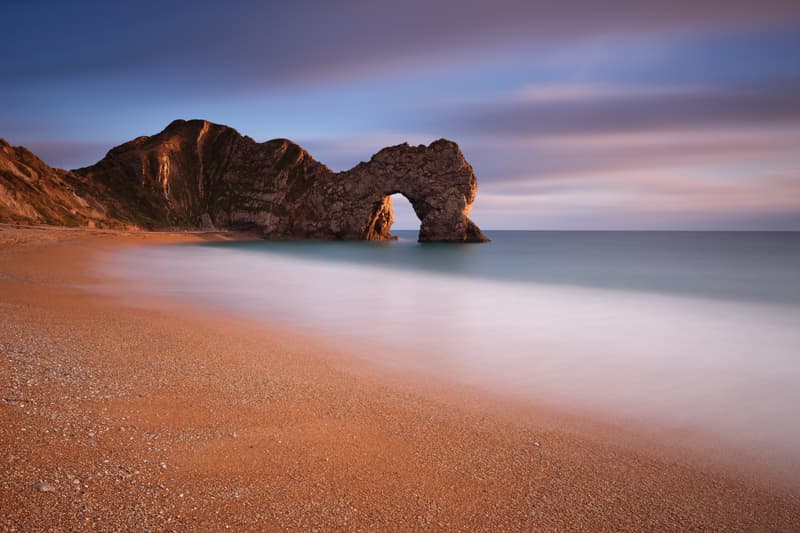Photo Insight with David Noton
 One of the foremost travel and landscape photographers working today, David Noton tirelessly travels the world in search of new challenges, which he shares with you here
One of the foremost travel and landscape photographers working today, David Noton tirelessly travels the world in search of new challenges, which he shares with you here
Durdle Door is a location I think of as my patch – it’s down the road from where I live and it’s where my family are from. This famous stretch of coast, known as the Jurassic Coast, is now a UNESCO World Heritage site. I feel I have a real connection with this area. In truth, it is one of my favourite places in the world. It’s a well-known location and this iconic arch has been photographed countless times, but it’s one of those places where there are so many variables its photographic potential is endless.
One of my best-selling images was taken at Durdle Door (see image below). It’s a panoramic photograph taken on a Fujifilm GX617 with a 105mm lens. When I found myself at Durdle Door one winter’s afternoon I couldn’t resist photographing the scene again, but I didn’t want to replicate the other image – I wanted to create something different (see image above).
On this occasion I planned to use a really long exposure to show the movement of the clouds through the frame. This was the element that brought something new to the picture. I’d used the movement in the water in previous shots, but I hadn’t used such a long exposure to show the streaking movement in the sky. I was using a 10-stop ND filter called the Lee Big Stopper, which gave me the long exposure I wanted – in this case 4mins. The aperture was f/11 and my camera was set to ISO 100. I love the contrast between the textured beach and silky water. It’s tempting to reach out and touch the image! There was a beautiful sky and lovely light, with the sun just about to dip down below the horizon. The last rays of the day are falling on the rocks along the edge of the coast, picking out textures on the rocks. Here the soft colours and light in the sky complement the softness of the water.
I used my Canon EOS-1Ds Mark III camera mounted on a tripod with my Canon TS-E 24mm f/3.5L lens. It is one of my favourite lenses for landscape photography and I always have it with me. I didn’t use the tilt-and-shift function for this image, but this lens is so incredibly sharp that it’s ideal for photographing landscapes.

You can go down to Durdle Door and, depending on where the waves are coming from or how stormy it’s been, the beach can be very smooth or rough. I’ve been there on a winter’s afternoon, with the waves crashing onto the shore, and there’s been so much spray it’s difficult to create an image. In this case, the waves were gently sweeping across the beach and coming up to the feet of the tripod. It was a wonderful tranquil evening. There was movement in the water, but not too much and just enough movement in the sky to create interest.
The colour temperature of the light at this time of the day even in winter is quite warm, and that warmth is what you can see on the beach and arch in the background. You can choose to set your camera to auto white balance so the camera will try to neutralise the colour balance. However, I prefer to shoot my landscape images using the daylight white balance setting so that if the light is warm and golden, I can record it as such – I don’t want the camera to make corrections for me.
I hardly ever alter the colour balance of my images; I go with what nature gives me. It’s about putting yourself in the right situation and taking time to understand how the light works within the scene. This understanding of how light and subject interact comes from visiting a location repeatedly in different lighting conditions, at different times of the day and even different times of the year. If you really study how the two play off each other, you’ll gradually build an awareness of the different properties of light. It’s about learning to be in tune with the light. For me, this is one of the joys of being at a location.
Before you even get your camera out of the bag, look at the scene in front of you and think how the different elements can work together in the frame. This image, for example, is not just about the cove, the beach, the water or the sky – it’s about how these elements relate to each other. The arch is such a dominant, bold shape it becomes the main compositional feature, but you also need to be aware how the other elements relate to this. It’s about keeping things simple and making sure there is nothing to pull your eye away from the subject.
David Noton was speaking to Gemma Padley
 David Noton’s new book Full Frame, priced £25 and published by David & Charles, is now available. It follows David’s journey to ten different locations around the world and gives invaluable insight into his approach and working methods. To see more images by David visit www.davidnoton.com
David Noton’s new book Full Frame, priced £25 and published by David & Charles, is now available. It follows David’s journey to ten different locations around the world and gives invaluable insight into his approach and working methods. To see more images by David visit www.davidnoton.com







